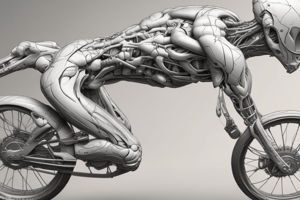Podcast
Questions and Answers
What are the two types of postures?
What are the two types of postures?
Inactive postures and active postures
What does the acronym POSTURE stand for?
What does the acronym POSTURE stand for?
- On the forefoot
- Stable joints (correct)
- Pelvis is neutral (correct)
- Ear level with shoulder (correct)
The spine has four natural curves.
The spine has four natural curves.
False (B)
What is the significance of a plumb line in posture assessment?
What is the significance of a plumb line in posture assessment?
Bad posture can cause ______ and increase the risk of falling.
Bad posture can cause ______ and increase the risk of falling.
What are some common causes of poor posture?
What are some common causes of poor posture?
What is a consequence of unbalanced muscle strength in athletes?
What is a consequence of unbalanced muscle strength in athletes?
Kyphosis is commonly found in swimmers.
Kyphosis is commonly found in swimmers.
Flashcards are hidden until you start studying
Study Notes
Posture Overview
- Posture refers to the body's position, which can be static (inactive) or dynamic (active).
- Key concepts include the stability provided by coordinated muscle activity and adaptation during movement.
- Postures can be classified into inactive and active postures.
POSTURE Acronym
- P: Pelvis in neutral position, weight evenly distributed.
- O: Weight on the whole foot.
- S: Joints should be stable.
- T: Abdominals engaged and tight.
- U: Ribs positioned upright.
- R: Shoulders midway retracted.
- E: Ears aligned level with shoulders.
Posture Assessment
- Proper spine alignment is crucial to good posture, maintaining natural curves in the neck, upper/mid back, and lower back.
- Ideal posture ensures the head is above the shoulders, aligning with the hips.
- Assessment techniques include using a plumb line to determine alignment through key body points, ensuring symmetry and even weight distribution.
- Key assessment areas include head alignment, spinal curvature, shoulder and pelvic symmetry, and joint alignment in the hips, knees, and ankles.
Risks of Poor Posture
- Misaligns the musculoskeletal system, increasing spinal pressure leading to injuries.
- Causes pain in the neck, shoulders, and back, and reduces flexibility.
- Impacts joint mobility, balance, and can worsen digestion and breathing.
- In women, may contribute to core muscle imbalances, resulting in incontinence or pelvic organ prolapse.
Posture and Pain Relationship
- Poor posture may exacerbate low back pain; improved postural control can alleviate discomfort.
- Common contributors to poor posture include muscle tension/weakness, excess weight, occupation, past injuries, and bad habits.
Postural Alignment and Gravity
- Correct posture aligns body so the gravity line passes through joint axes, reducing stress on soft tissues.
- Imbalance occurs if one muscle group tightens while its antagonist elongates, affecting stability.
Malposture in Sports
- Certain sports may overemphasize specific muscle groups, leading to muscle imbalances (e.g., quadriceps vs. hamstrings).
- Anterior pelvic tilt often results from these imbalances, causing spinal hyperlordosis.
- Common sport-specific postural issues:
- Cyclists: Kyphotic thoracic spine.
- Volleyball players: Asymmetrical muscle imbalance and spine asymmetry.
- Power athletes: Frequent lordosis.
- Swimmers: Common to experience kyphosis.
- Soccer players: High injury rates, especially in lower limbs, risking ACL injuries.
Studying That Suits You
Use AI to generate personalized quizzes and flashcards to suit your learning preferences.




